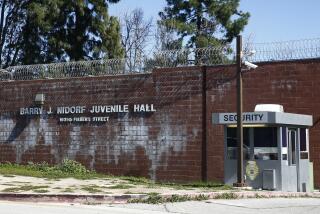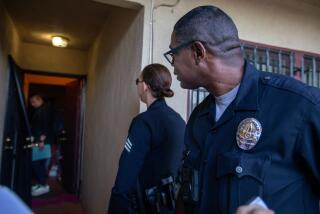IRVINE : Service Puts Victims, Offenders Together
A teen-age “tagger” came face to face last week with the man whose property he vandalized with graffiti. The encounter began under a cloud of ambivalence and suspicion. But in the end, it produced something far more unusual in the relationship between lawbreaker and victim: mutual understanding.
The two parties were brought together by the Victim Offender Reconciliation Program, a 5-year-old service designed to address the emotional toll of crime through talk instead of violence.
More than 500 juvenile offenders and their victims go through the mediation program each year. Demand has increased so dramatically over the last few years that organizers are seeking volunteer mediators. They plan a training session next month at UC Irvine.
“Not a lot of time and energy is usually devoted to the human element of crime,” said Michael Niemeyer, director of the program, which is run out of the St. Vincent de Paul Center for Community Reconciliation in Orange. “What we find is that dealing with this is important.”
The program receives many referrals from the juvenile courts. Usually, the offender has been ordered by the justice system to offer some sort of restitution to the victim and a program mediator is called in to help work out a deal.
Most cases handled by the program involve theft, burglary or assaults. Mediators work on one crime a month. That usually requires meeting with both the victim and the offender alone and then arranging a group encounter, which the offender’s parents must attend.
“It could be a very volatile situation because the people (the mediator) deals with can be very angry,” Neimeyer said. “When people are given an opportunity to express their feelings, they don’t resort to violence. This allows people to express themselves.”
From this expression, he said, comes understanding. This was evident at the meeting last week between the tagger and the property owner, which Neimeyer helped mediate.
The tagger learned the “human consequences” of his actions. “He painted the wall, and all he saw was the wall,” Neimeyer said. “This really hurt people, not just the wall.”
As for the property owner, he gained insight into the teen-ager’s mind-set and what prompted him to vandalize the property. In the end, both parties agreed that the teen-ager will do some landscaping around the victim’s property.
The next training session for people interested in serving as volunteer mediators begins on March 26. For more information, call (714) 633-6551.
More to Read
Sign up for Essential California
The most important California stories and recommendations in your inbox every morning.
You may occasionally receive promotional content from the Los Angeles Times.










